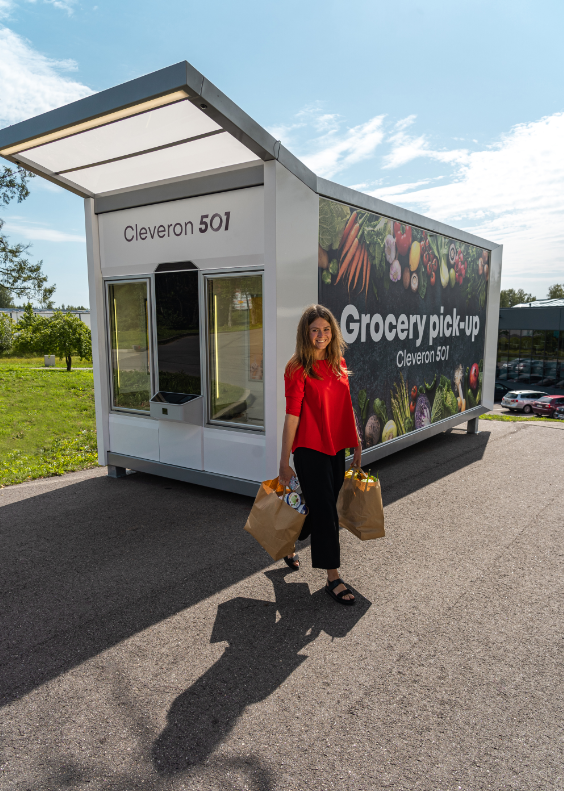Cleveron launches the world’s first ‘grocery robot’ with two temperature zones
Everyone’s familiar with vending machines – the ones that dispense food and drinks after you pay into it, perhaps using cash or a card.
But they’ve evolved into much larger systems which could be described as fully automated stores.
A company called Cleveron calls the automated stores it supplies “robots”, which makes us wonder yet again about the definition of a robot.
We think a robot is something that moves within its own autonomous program. A structure which looks and operates like a large vending machine we would probably continue to describe as an automated store.
Nonetheless, Cleveron describes itself as a “last mile” robotics solutions provider, the phrase “last mile” referring to the part of the journey made to reach the end customer.

The startup company has introduced its “Cleveron 501”, describing it as a “one-of-a-kind grocery robot that enables grocery pick-up in just 20 seconds”.
Cleveron 501 is an efficient delivery alternative to home delivery, making grocery click and collect cheaper, faster and more convenient for both grocers and consumers.
Arno Kütt, Cleveron’s CEO, says: “Cleveron is known for creating innovative click and collect solutions for the world’s biggest retailers.
“With Cleveron 501, we are going one step further and entering the grocery click and collect market. The principles of our robots remain the same – they will save time for everyone.
“Time is one of the most valuable resources, and it shouldn’t be wasted queuing in stores or waiting for a courier at home.
“With Cleveron 501 you can pick up your everyday groceries whenever and wherever it is suitable for you.
“The potential for grocery robots is also tremendous – grocery delivery can now move closer to the consumers and offer a much-needed service in places where it has previously been unattainable, like in business districts, where there is not enough room for supermarkets.“
Cleveron 501 helps to offer an “excellent experience” for click and collect customers – a segment which is undoubtedly growing.
It is expected that the US online food and beverage sales will grow 18.2 per cent to $19.89 billion in 2019. By 2023, the online grocery sales are anticipated to more than quadruple.
As a “unique solution” in the click and collect market, Cleveron 501 is available in two temperature zones.
The standard model is a single temperature unit with adjustable internal temperature between +2 °C…+25 °C (+36 °F…+77 °F). It also has an optional freezer zone with the controlled temperature of -18 °C (0 °F).
Cleveron says this makes its “grocery robot” – or automated grocery store – suitable for storing both perishables and frozen food, ensuring the high quality of goods at the moment of pickup by the consumer.
Operating the grocery robot is a time-saving solution for the grocers, couriers and customers. The robot is filled through one user console so there is no need to walk between different locker doors.
The customers can collect their groceries by scanning or entering the order code at the console after which the robot will present their order. The grocery pickup can be completed in just 20 seconds.
Cleveron 501 enables the grocers to offer 24/7 convenient self-service outdoor pick up right where their customers are.
The footprint can be compared to an average parking space and setting up the robot requires only a solid surface, power and a network cable.
This makes it possible to offer pickup services next to the original supermarket, in busy city centers, university campuses and other locations where retail space is scarce or expensive.
Cleveron 501 is available in two sizes, with a maximum hold of up to 276 crates.
Cleveron 501 is the first grocery robot from the Estonian-based Cleveron, which provides robotics-based click and collect solutions to some of the biggest names in retail, such as:
- Walmart (Cleveron 401 or the Pickup Tower);
- Zara (Cleveron 402);
- The Warehouse (Cleveron 401);
- Decathlon (Cleveron 402); and
- others.
Cleveron’s parcel robots and lockers are used in 22 countries, issuing 1.3 million parcels every month.

